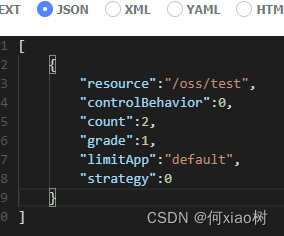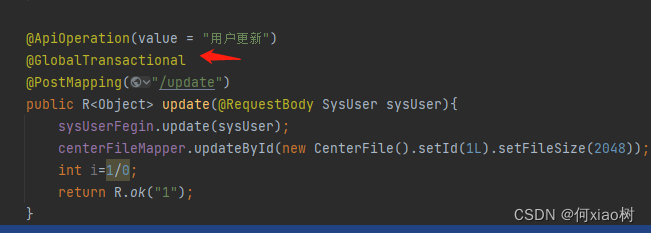Spring Cloud Alibaba 微服务各组件整合项目:
版本说明:
- <spring-boot.version>2.6.3</spring-boot.version>
- <spring-cloud.version>2021.0.1</spring-cloud.version>
- <spring-cloud-alibaba.version>2021.0.1.0</spring-cloud-alibaba.version>
- <swagger.fox.version>3.0.0</swagger.fox.version>
- <knife4j.version>3.0.3</knife4j.version>
- <nacos.server>1.4.2</nacos.server>
- <seata.server>1.4.2</seata.server>
- <sentinel.dashboard>1.8.3</sentinel.dashboard>
- <skywalking.walking>9.0-8.10</skywalking.walking>
依赖前置:
<?xml version="1.0" encoding="UTF-8"?>
<project xmlns="http://maven.apache.org/POM/4.0.0"
xmlns:xsi="http://www.w3.org/2001/XMLSchema-instance"
xsi:schemaLocation="http://maven.apache.org/POM/4.0.0 http://maven.apache.org/xsd/maven-4.0.0.xsd">
<modelVersion>4.0.0</modelVersion>
<groupId>com.xiaoshu</groupId>
<artifactId>alibaba-cloud-example</artifactId>
<version>1.0-SNAPSHOT</version>
<packaging>pom</packaging>
<properties>
<java.version>1.8</java.version>
<project.build.sourceEncoding>UTF-8</project.build.sourceEncoding>
<maven.compiler.source>1.8</maven.compiler.source>
<maven.compiler.target>1.8</maven.compiler.target>
<maven.compiler.version>3.8.1</maven.compiler.version>
<spring-boot.version>2.6.3</spring-boot.version>
<spring-cloud.version>2021.0.1</spring-cloud.version>
<spring-cloud-alibaba.version>2021.0.1.0</spring-cloud-alibaba.version>
<swagger.fox.version>3.0.0</swagger.fox.version>
<knife4j.version>3.0.3</knife4j.version>
<jasypt.version>3.0.3</jasypt.version>
</properties>
<modules>
<module>cloud-gateway</module>
<module>cloud-oss</module>
<module>cloud-upms</module>
<module>cloud-common</module>
<module>cloud-auth</module>
</modules>
<dependencies>
<!--bootstrap 启动器-->
<dependency>
<groupId>org.springframework.cloud</groupId>
<artifactId>spring-cloud-starter-bootstrap</artifactId>
</dependency>
<!--配置文件处理器-->
<dependency>
<groupId>org.springframework.boot</groupId>
<artifactId>spring-boot-configuration-processor</artifactId>
<optional>true</optional>
</dependency>
<!--jasypt配置文件加解密-->
<dependency>
<groupId>com.github.ulisesbocchio</groupId>
<artifactId>jasypt-spring-boot-starter</artifactId>
<version>${jasypt.version}</version>
</dependency>
<!--Lombok-->
<dependency>
<groupId>org.projectlombok</groupId>
<artifactId>lombok</artifactId>
<scope>provided</scope>
</dependency>
</dependencies>
<dependencyManagement>
<dependencies>
<!--spring boot 公共版本定义-->
<dependency>
<groupId>org.springframework.boot</groupId>
<artifactId>spring-boot-dependencies</artifactId>
<version>${spring-boot.version}</version>
<type>pom</type>
<scope>import</scope>
</dependency>
<!--spring cloud 公共版本定义 通过dependencies完成继承-->
<dependency>
<groupId>org.springframework.cloud</groupId>
<artifactId>spring-cloud-dependencies</artifactId>
<version>${spring-cloud.version}</version>
<type>pom</type>
<scope>import</scope>
</dependency>
<!--spring cloud alibaba-->
<dependency>
<groupId>com.alibaba.cloud</groupId>
<artifactId>spring-cloud-alibaba-dependencies</artifactId>
<version>${spring-cloud-alibaba.version}</version>
<type>pom</type>
<scope>import</scope>
</dependency>
</dependencies>
</dependencyManagement>
<build>
<finalName>${project.name}</finalName>
<resources>
<resource>
<directory>src/main/resources</directory>
<filtering>true</filtering>
</resource>
</resources>
<pluginManagement>
<plugins>
<!--spring boot 默认插件-->
<plugin>
<groupId>org.springframework.boot</groupId>
<artifactId>spring-boot-maven-plugin</artifactId>
<version>${spring-boot.version}</version>
<executions>
<execution>
<goals>
<goal>repackage</goal>
</goals>
</execution>
</executions>
</plugin>
</plugins>
</pluginManagement>
<plugins>
<!--代码编译指定版本插件-->
<plugin>
<groupId>org.apache.maven.plugins</groupId>
<artifactId>maven-compiler-plugin</artifactId>
<version>${maven.compiler.version}</version>
<configuration>
<target>${maven.compiler.target}</target>
<source>${maven.compiler.source}</source>
<encoding>UTF-8</encoding>
<skip>true</skip>
</configuration>
</plugin>
</plugins>
</build>
<profiles>
<profile>
<id>dev</id>
<properties>
<!-- 环境标识,需要与配置文件的名称相对应 -->
<profiles.active>dev</profiles.active>
</properties>
<activation>
<!-- 默认环境 -->
<activeByDefault>true</activeByDefault>
</activation>
</profile>
</profiles>
<!-- 配置内网仓库地址
<distributionManagement>
<repository>
<id>jiuding-releases</id>
<name>jiuding nexus release repository</name>
<url>http://ip:port/repository/maven-releases</url>
</repository>
<snapshotRepository>
<id>jiuding-snapshots</id>
<name>jiuding nexus snapshots repository</name>
<url>http://ip:port/repository/maven-snapshots</url>
</snapshotRepository>
</distributionManagement>
-->
</project>
nacos
- 中文官网: https://nacos.io/zh-cn/docs/v2/quickstart/quick-start.html
- 简介: 动态服务发现、配置管理和服务管理平台
- 启动: sh startup.sh -m standalone
- 关键特性:
- 配置中心、服务管理
- 动态配置服务; @RefreshScope 可以动态修改yml对应属性
- 动态 DNS 服务 ; 支持权重路由,让您更容易地实现中间层负载均衡、更灵活的路由策略、流量控制
- 注册表更新大量运用 copyonwrite思想防止读写冲突
- 使用:
- DataId 为 服务名称.yml + ${profiles.active}
- extension-configs属性 本应用额外配置
- shared-configs 属性表示共享配置
- 持久化:
- nacos运行体/config/nacos-mysql.sql 导入数据库,修改 application.properties 配置使用外部数据源
nacos 源码获取:
- gitlub 下载对应版本
- install 一下
- console 模块为启动模板;
- 其它模块pom引入,console保留源码启动,可以配合开发调试
// 编译install
cd nacos/
mvn -Prelease-nacos -Dmaven.test.skip=true clean install -U
ls -al distribution/target/
/**
* Nacos starter.
*
* @author nacos
*/
@SpringBootApplication(scanBasePackages = "com.alibaba.nacos")
@ServletComponentScan
@EnableScheduling
public class Nacos {
public static void main(String[] args) {
if(initEnv()){
SpringApplication.run(Nacos.class, args);
}
}
/**
* 单机启动
*/
private static boolean initEnv() {
System.setProperty("nacos.standalone", "true");
return true;
}
}
nacos 服务列表获取示例:
@Data
public class CatalogServiceVo implements Serializable {
private Integer count;
private List<NacosServiceVo> serviceList;
}
@Data
public class NacosServiceVo implements Serializable {
private String name;
private String groupName;
private Integer clusterCount;
private Integer ipCount;
private Integer healthyInstanceCount;
private String triggerFlag;
}
Object o = catalogServiceV2
.pageListService(Constants.DEFAULT_NAMESPACE_ID,
StringUtils.EMPTY,
StringUtils.EMPTY,
1, Integer.MAX_VALUE,
StringUtils.EMPTY,
false);
CatalogServiceVo catalogService = JSONUtil.toBean(o.toString(), CatalogServiceVo.class);
List<NacosServiceVo> serviceList = catalogService.getServiceList();
sentinel
-
启动:java -Dserver.port=8858 -Dcsp.sentinel.dashboard.server=localhost:8858 -Dproject.name=sentinel-dashboard -jar sentinel-dashboard-1.8.3.jar
-
使用:启动一个服务包,yml配置注册;以接口地址以服务资源,配置限流等规格
-
简介:分布式服务架构的流量控制组件,主要以流量为切入点,从限流,流量整形、熔断降级、系统负载保护、热点保护等多个维度保证服务稳定性
- 核心库(代码控制) @SentinelResource 、控制台
-
概念:
- 服务雪崩:微服务之间存在许多交叉调用,因某服务出现异常导致依赖服务异常,从而导致多服务不可用
- 服务降级:当服务熔断后,该服务不可调用,此时客户端返回一个缺省回调值,一般用于弱依赖服务如积分服务
-
流控:
- 规则:监控应用流量的QPS或并发线程数等指标,当达到指定阀值时对流量进行控制,避免被顺时高峰流量冲垮,保障应用可用性
- 针对项:QPS (每秒请求数)、 线程数(等待设置线程数的线程响应时,其它请求线程才会被处理 )
- 关联流控:设置关联资源,当关联资源达到阀值时,当前资源被限制
- 链路流控: A->B A->C ,针对A 设置规则,入口资源设置 C,当达到限制指标时,C会被流控 B没影响
- 热点流控:针对某热点数据进行流控; 热点商品、ip限制、防刷;(如针对商品id为1的商品进行限流)
- 流控效果
- 快速失败:直接拒绝
- warm up(预热):在预热时间断内,慢慢的增加放入的请求, 3个流量 - 5个流量 -10个流量;冷加载因子:3 ;适合激增流量
- 排队等待:阈值为5,来了10个流量则有5个流量等待,在超时时间里有处理完的请求,则进入一个等待流量。适合脉冲流量
- 规则:监控应用流量的QPS或并发线程数等指标,当达到指定阀值时对流量进行控制,避免被顺时高峰流量冲垮,保障应用可用性
-
服务降级:
- 熔断规则:
- 慢调用比例:接口响应时长,最小请求数,比例;在熔断时长结束后进入半开状态
- 异常比例
- 异常数
- 熔断规则:
-
fegin 整合:
- feign.sentinel.enabled=true 开启
-
系统规则:
- 针对全局设置的一个兜底方案,如 load、cpu使用率、平均RT、QPS,等达到设置比例时,出发系统防护,全结果返回系统防护异常
-
网关流控:
- 整合 pom 引入 spring-cloud-alibaba-sentinel-gateway、yml链接控制台
- 针对路由id进行规则设置,设置 Api分组进行匹配限流设置
-
sentinel-nacos持久化:
- 规则默认存储在内存中,服务重启后就会丢失;一般都生产环境都会配置规则持久化
- 步骤:
- 1.pom引入依赖
- 2.yml配置sentinel-datasource-nacos
- 3.nacos中配置对应规则json
spring:
profiles:
active: @profiles.active@
application:
name: @artifactId@
cloud:
nacos:
discovery:
server-addr: ${
NACOS_HOST:127.0.0.1}:${
NACOS_PORT:8848}
config:
server-addr: ${
spring.cloud.nacos.discovery.server-addr}
file-extension: yml
shared-configs:
- application-${
spring.profiles.active}.${
spring.cloud.nacos.config.file-extension}
sentinel:
transport:
dashboard: 127.0.0.1:8858
#clientIp: 127.0.0.1 #服务与sentinel 不在同一服务器时需:指定当前服务ip
#关闭链路收敛,链路限流
web-context-unify: false
#规则持久化
datasource:
flow-rule:
nacos:
server-addr: 127.0.0.1:8848
username: nacos
paswword: nacos
data-id: cloud-oss-flow-rlue #对应nacos dataId,且nacos要持久化
rule-type: flow

Seata(AT) 分布式事务组件
- 官网: https://seata.io/zh-cn/docs/overview/what-is-seata.html
- 使用:同样启动一个seta服务包配置好对应数据,yml配置连接seata;
@GlobalTransactional标注则可以 - 概念:
- 2PC:预处理、提交/回滚 (分布式事务完成分两阶段)
- 事务协调者发送事务请求-》(阻塞) 事务参与者(数据库、服务)是否可执行事务,参与者执行事务请求,成功执行事务操作并写入undo、redo 日志后返回确认应答,否返回NO
- 事务协调者向参与者发送commit请求,提交事务,完成后释放事务暂用资源
- 只能尽力保证事务,如响应中断等
- AT模式(无侵入,有锁):
- 拦截业务sql提前表元数据,保存原快照;执行业务SQL后保存新快照,并添加行锁
- 提交成功,删除快照数据以及行锁
- 提交失败,对比当前数据与更新后快照数据是否一致,一致则用更新前快照还原业务数据,不一致则出现脏毒,人为处理
- TCC模式(侵入,无锁):
- 根据自己的业务场景实现 Try(一阶段执行) 、 Confirm(二阶段提交) 、 Cancel(二阶段回滚),由用户自己控制具体逻辑;
- 2PC:预处理、提交/回滚 (分布式事务完成分两阶段)
<!-- seata -->
<dependency>
<groupId>com.alibaba.cloud</groupId>
<artifactId>spring-cloud-starter-alibaba-seata</artifactId>
</dependency>
#seata 配置
seata:
registry:
type: nacos
nacos:
server-addr: 127.0.0.1:8848
application: seata-server
username: nacos
password: nacos
group: SEATA_GROUP
config:
type: nacos
nacos:
server-addr: 127.0.0.1:8848
username: nacos
password: nacos
group: SEATA_GROUP
tx-service-group: my_test_tx_group

GateWay 统一网关
- 网关Swagger: 微服务网关文档,通过
nacos获取服务列表,根据文档注解获取对应接口信息 - 断言路由(predicates)
- 内置断言:
- 基于时间
- 请求头
- 域名
- 请求方式
- 请求参数
- ip匹配
- Cookie
- 自定义 xxxRoutePredicateFactory extends AbstractRoutePredicateFactory
- 内置断言:
- (过滤器)filters
- 内置过滤:
- AddRequestHeader=key, vlaue 添加请求头
- 自定义 xxxGateWayFilterFactory extends AbstractNameValueGatewayFilterFactory
- 全局过滤器 xxx implements GlobalFilter
- 内置过滤:
server:
port: 9999
spring:
application:
name: @artifactId@
profiles:
active: @profiles.active@
cloud:
nacos:
discovery:
server-addr: ${
NACOS_HOST:127.0.0.1}:${
NACOS_PORT:8848}
config:
server-addr: ${
spring.cloud.nacos.discovery.server-addr}
file-extension: yml
sentinel:
transport:
dashboard: 127.0.0.1:8858
gateway:
discovery:
locator:
enabled: true
routes:
- id: cloud-auth-route
uri: lb://cloud-auth
predicates:
- Path=/auth/**
filters:
- StripPrefix=1
- id: cloud-oss-biz-route
uri: lb://cloud-oss-biz
predicates:
- Path=/oss/**
filters:
- StripPrefix=1
- id: cloud-upms-biz-route
uri: lb://cloud-upms-biz
predicates:
- Path=/upms/**
filters:
- StripPrefix=1
skywalking 链路跟踪
- 官网:https://skywalking.apache.org/
- 文档:https://skyapm.github.io/document-cn-translation-of-skywalking/
- 简介:国产开源框架,分布式系统应用程序性能监视工具;分布式链路跟踪,性能指标分析,应用服务依赖分析
- 组成:
- oapservice: skywalking服务端处理监控接收数据 端口:11800 12800
- wepapp-ui: 数据展示业务 端口: webapp.yml
- agent: 服务端绑定探针,收集数据
- 可选插件:
- optional-plugins/gateway
- 微服务集成:
本地集成
-javaagent:D:\java_project\alibaba-cloud-example\environment\skywalking9.0-8.10\apache-skywalking-apm-bin\skywalking-agent\skywalking-agent.jar
-Dskywalking.agent.service_name=cloud-gateway
-Dskywalking.collector.backend_service=127.0.0.1:11800
- 持久化:
- config\application.yml ; storage.selector 配置数据库,默认是H2内存数据库
- 自定义链路追踪:对项目中的业务方法,实现链路跟踪,方便排查问题
- 在业务接口上标记 @Trace ,以及针对方法 @Tag(key = “标记名称”,value = “returnedObj”)
- 性能剖析:
- 针对慢接口,定位慢请求慢响应问题;
- 性能剖析项,新建任务
- 日志:
- 添加依赖,配置 logback-spring.xml ,注意配置 grpc-log上报日志
- skywalking未部署在本地时,注意修改 skywalking-agent\config\agent.config
<!-- 自定义链路追踪,与服务版本一致 -->
<dependency>
<groupId>org.apache.skywalking</groupId>
<artifactId>apm-toolkit-trace</artifactId>
<version>8.10.0</version>
</dependency>
<!-- 日志追踪 -->
<dependency>
<groupId>org.apache.skywalking</groupId>
<artifactId>apm-toolkit-logback-1.x</artifactId>
<version>8.10.0</version>
</dependency>
- 告警:
- 针对接口响应时间、数据库访问平均时间等进行告警 alarm-settings.yml 规则配置包含基本默认告警规则
- 网络钩子,告警时会发送请求;推送到接口、微信、钉钉、邮件等…
Outh2 微服务授权
- 协议:关于授权的开发网络标准,使得第三方应用有权利去访问http服务,处理用户与资源之间的关系
- 流程:
- 在
通用security模块,讲yml配置的忽略路径、以及忽略鉴权注解标注的controller、接口,对应路径注册入security中registry.antMatchers(HttpMethod.valueOf(method), strings.get(0)).permitAll(); - 对应的
fegin调用,需要配置请求头,防止微服务内调用鉴权失败
- 在
@Configuration
public class FeignOauth2RequestInterceptor implements RequestInterceptor {
private final String AUTHORIZATION_HEADER = "Authorization";
private final String BEARER_TOKEN_TYPE = "Bearer";
@Override
public void apply(RequestTemplate requestTemplate) {
SecurityContext securityContext = SecurityContextHolder.getContext();
Authentication authentication = securityContext.getAuthentication();
if (authentication != null && authentication.getDetails() instanceof OAuth2AuthenticationDetails) {
OAuth2AuthenticationDetails details = (OAuth2AuthenticationDetails) authentication.getDetails();
requestTemplate.header(AUTHORIZATION_HEADER, String.format("%s %s", BEARER_TOKEN_TYPE, details.getTokenValue()));
}
}
}
@Configuration
public class FeignRequestConfiguration {
@Bean
public RequestInterceptor requestInterceptor() {
return new FeignOauth2RequestInterceptor();
}
}
- 针对各个客户端认证,implements ClientDetailsService 配置对应的认证方式
@Component
public class CloudClientDetailsServiceImpl implements ClientDetailsService {
@Resource
private SysOauthClientDetailsFegin sysOauthClientDetailsFegin;
@Resource
protected PasswordEncoder passwordEncoder;
@Override
public ClientDetails loadClientByClientId(String s) throws ClientRegistrationException {
BaseClientDetails target = new BaseClientDetails();
SysOauthClientDetails param = new SysOauthClientDetails().setClientId(s);
//fegin调用,获取对应 客户端信息
SysOauthClientDetails oauthClientDetails = sysOauthClientDetailsFegin.getByClientId(param).getData();
if (oauthClientDetails==null){
throw new SecurityException("未找到应用信息!");
}
setClient(target, oauthClientDetails);
return target;
}
/**
* 赋值客户端信息
* @param target target
* @param oauthClientDetails 客户端数据
*/
private void setClient(BaseClientDetails target, SysOauthClientDetails oauthClientDetails) {
target.setClientId(oauthClientDetails.getClientId());
target.setClientSecret(passwordEncoder.encode(oauthClientDetails.getClientSecret()));
if (ArrayUtil.isNotEmpty(oauthClientDetails.getAuthorizedGrantTypes())) {
target.setAuthorizedGrantTypes(Arrays.asList(oauthClientDetails.getAuthorizedGrantTypes().split(",")));
}
if (StrUtil.isNotBlank(oauthClientDetails.getAuthorities())) {
target.setAuthorities(AuthorityUtils.commaSeparatedStringToAuthorityList(oauthClientDetails.getAuthorities()));
}
if (StrUtil.isNotBlank(oauthClientDetails.getResourceIds())) {
target.setResourceIds(StringUtils.commaDelimitedListToSet(oauthClientDetails.getResourceIds()));
}
if (StrUtil.isNotBlank(oauthClientDetails.getWebServerRedirectUri())) {
target.setRegisteredRedirectUri(StringUtils.commaDelimitedListToSet(oauthClientDetails.getWebServerRedirectUri()));
}
if (StrUtil.isNotBlank(oauthClientDetails.getScope())) {
target.setScope(StringUtils.commaDelimitedListToSet(oauthClientDetails.getScope()));
}
if (StrUtil.isNotBlank(oauthClientDetails.getAutoapprove())) {
target.setAutoApproveScopes(StringUtils.commaDelimitedListToSet(oauthClientDetails.getAutoapprove()));
}
if (oauthClientDetails.getAccessTokenValidity() != null) {
target.setAccessTokenValiditySeconds(oauthClientDetails.getAccessTokenValidity());
}
if (oauthClientDetails.getRefreshTokenValidity() != null) {
target.setRefreshTokenValiditySeconds(oauthClientDetails.getRefreshTokenValidity());
}
}
}
认证服务器配置:
/**
* @author xiaoshu
* @description 认证服务器配置
* 配置token存储
* 配置第三方应用
* @date 2022年11月13日 12:44
*/
@ConditionalOnProperty(prefix = "auth",name = "method",havingValue = "redis")
@Configuration
@EnableAuthorizationServer
//@EnableResourceServer //资源服务器,获取资源前不需要登录,携带token就可以了
@EnableGlobalMethodSecurity(prePostEnabled = true) //开启方法级别权限
public class AuthorizationServerConfig extends AuthorizationServerConfigurerAdapter {
@Resource
private RedisConnectionFactory redisConnection;
@Resource
protected PasswordEncoder passwordEncoder;
/**
* 注入认证管理器
*/
@Resource
private AuthenticationManager authenticationManager;
@Bean
public TokenStore tokenStore(){
return new RedisTokenStore(redisConnection);
}
@Resource
private ClientDetailsService cloudClientDetailsServiceImpl;
@Override
public void configure(ClientDetailsServiceConfigurer clients) throws Exception {
clients.withClientDetails(cloudClientDetailsServiceImpl);
}
/**
* 配置第三方应用 "authorization_code", "password", "client_credentials", "implicit", "refresh_token"
* 1. code吗授权 authorization_code
* 2. 静默授权 implicit
* 3. 密码授权 (特别信任第三方应用) password
* 4. 客户端授权 (直接通过浏览器就能获取token) client_credentials
* @param clients
* @throws Exception
*/
/*@Override
public void configure(ClientDetailsServiceConfigurer clients) throws Exception {
clients.inMemory()
//code授权
.withClient("web")
.secret(passwordEncoder.encode("web-secret"))
.scopes("all") //配置第三方应用的业务作用域
.authorizedGrantTypes("authorization_code") //授权类型
.accessTokenValiditySeconds(7200)
.redirectUris("https://www.baidu.com")
.and()
//静默授权
.withClient("wx")
.secret(passwordEncoder.encode("wx"))
.scopes("all")
.authorizedGrantTypes("implicit")
.accessTokenValiditySeconds(3600)
.redirectUris("https://www.baidu.com")
.and()
//密码授权, 这里要查询数据库用户,密码
.withClient("admin")
.secret(passwordEncoder.encode("admin"))
.scopes("all")
.authorizedGrantTypes("password")
.accessTokenValiditySeconds(3600)
.redirectUris("https://www.baidu.com")
.and()
//客户端授权
.withClient("client")
.secret(passwordEncoder.encode("client-secert"))
.scopes("all")
.authorizedGrantTypes("client_credentials")
.accessTokenValiditySeconds(500)
.redirectUris("https://www.baidu.com");
}*/
/**
* 需要暴露授权服务给token存储
* 暴露授权服务器给认证管理器
* @param endpoints
* @throws Exception
*/
@Override
public void configure(AuthorizationServerEndpointsConfigurer endpoints) throws Exception {
endpoints.tokenStore(tokenStore()).authenticationManager(authenticationManager);
}
}
- 概念:
- 资源服务器:托管受保护资源的服务器(具体服务器),能够接受并使用访问令牌响应受保护的资源请求;各微服务为资源服务器,如提供接口
- 资源所有者:能够授予对受保护资源的访问权限的实体。当资源所有者是一个人时,它称为最终用户
- 授权服务器:请求授权成功后,服务器向客户端发布访问令牌认证资源所有者并获得授权
- 客户端:对我们的产品来说,QQ、微信登录是第三方登录系统。我们又需要第三方登录系统的资源
- 授权模式:
- 授权码(authorization-code)
- 授权码-隐藏式(implicit)纯前端应用
- 密码式(password):直接对应用提供用户名和密码
- 客户端凭证(client credentials):没有前端的命令行应用,即在命令行下请求令牌
- 默认端点 DefaultSecurityFilterChain:
- /oauth/token
- /oauth/token_key
- /oauth/check_token
- token携带方式:
- GET ?access_token=xxx
- POST header Authorization:bearer 99a996e4-5fde-42ea-b5fb-2cc47d926925
- 各微服务整合:
- 除auth服务外,其它服务也是资源服务器
- Jwt整合实现(对称加密):
- new JwtTokenStore(jwtAccessTokenConverter())
- AuthorizationServerEndpointsConfigurer 暴露 .accessTokenConverter(jwtAccessTokenConverter())
- common模块配置token解析:ResourceServerConfig extends ResourceServerConfigurerAdapter,配置统一扫描包
- 非对称加密: https://oomake.com/download/openssl 工具下载 openssl
- 生成私钥:
- keytool -genkeypair -alias xiaoshu-jwt -validity 3650 -keyalg RSA -dname “CN=jwt,OU=jtw,O=jwt,L=zurich,S=zurich,C=CH” -keypass 730730 -keystore xiaoshu-jwt.jks -storepass 730730
- 生成公钥:
- keytool -list -rfc --keystore xiaoshu-jwt.jks | openssl x509 -inform pem -pubkey
- 注意maven配置resource
- 生成私钥:
# token 校检
security:
oauth2:
resource:
#相当于拿token换取用户信息
user-info-uri: http://localhost:3000/getUserInfo
授权码模式
- 流程:
- 1.第三方应该,先在授权服务器登记,生成 clientId clientSecert
- 2.登录后,访问重定向链接; 比如:QQ扫码第三方平台,也是要先登录QQ后,才会确认授权
- 3.确认授权后,获取code,通过code获取token
- state:是状态值,不透明,防止跨站点请求伪造
- redirect_uri:重定向地址,必须是公网 https请求
- 授权是在登录之后。
localhost:3000/oauth/authorize?response_type=code&client_id=web&state=sxt&redirect_uri=https://www.baidu.com
post
localhost:3000/outh/token?grant_type=authorization_code&code=iXB5jU&redirect_uri=https://www.baidu.com
head:
Authorization: Basic d2ViOndlYi1zZWNyZXQ= (vaue:为三方应用的 cinetId和clientSecret组合的 base64编码)
{
"access_token": "xxx",
"token_type": "bearer",
"expires_in": 7199,
"scope": "all"
}
静默授权模式
- 流程:
- 1.先在授权服务器登记,生成 clientId clientSecert,配置认证模式为,静默授权
localhost:3000/oauth/authorize?response_type=token&client_id=wx&state=sxt&redirect_uri=https://www.baidu.com
确认授权后,直接返回token:
https://www.baidu.com/#access_token=xxx&token_type=bearer&state=sxt&expires_in=3599&scope=all
密码授权模式
- 流程:
- 先在授权服务器登记,生成 clientId clientSecert
- 暴露 AuthenticationManager 认证管理器,配置授权方式为密码授权
post
localhost:3000/oauth/token?grant_type=password&username=name&password=pwd
head:
Authorization: Basic d2ViOndlYi1zZWNyZXQ= (vaue:为三方应用的 cinetId和clientSecret组合的 base64编码)
客户端授权模式
- 流程:
- 先在授权服务器登记,生成 clientId clientSecert
- 直接发起请求获取token
- 访问基本权限接口,不能访问特定权限接口!
post
localhost:3000/oauth/token?grant_type=client_credentials
head:
Authorization: Basic d2ViOndlYi1zZWNyZXQ= (vaue:为三方应用的 cinetId和clientSecret组合的 base64编码)
Swagger 微服务整合
- 文档:https://doc.xiaominfo.com/
- 微服务整合:https://gitee.com/xiaoym/swagger-bootstrap-ui-demo
- 网关整合:微服务整合swagger文档,涉及多个服务的切换, 所有进入文档首页,会请求resource接口,返回各服务对应文档资源
- implements SwaggerResourcesProvider 重写 get(),结合网关查询各微服务接口资源信息
- 添加 SwaggerHandler -> SwaggerResourcesProvider 获取接口资源
<!-- knife4j-->
<dependency>
<groupId>com.github.xiaoymin</groupId>
<artifactId>knife4j-spring-boot-starter</artifactId>
<version>${knife4j.version}</version>
</dependency>
<dependency>
<groupId>io.springfox</groupId>
<artifactId>springfox-boot-starter</artifactId>
<version>${swagger.fox.version}</version>
</dependency>
- 各服务整合:
- 注:此demo项目spring boot 版本2.6.x
@Configuration
@EnableOpenApi //注解启动用Swagger的使用,同时在配置类中对Swagger的通用参数进行配置
public class Swagger3Config implements EnvironmentAware {
private String applicationName;
private String applicationDescription;
@Bean
public Docket createRestApi(){
//返回文档概要信息
return new Docket(DocumentationType.OAS_30)
.apiInfo(apiInfo())
.select()
.apis(RequestHandlerSelectors.withMethodAnnotation(ApiOperation.class))
.paths(PathSelectors.any())
.build()
.globalRequestParameters(getGlobalRequestParameters())
.globalResponses(HttpMethod.GET,getGlobalResponseMessage())
.globalResponses(HttpMethod.POST,getGlobalResponseMessage());
}
/**
* 生成接口信息,包括标题,联系人等
* @return ApiInfo
*/
private ApiInfo apiInfo() {
return new ApiInfoBuilder()
.title(applicationName+"接口文档")
.description(applicationDescription)
.contact(new Contact("小树","http://www.baidu.com","[email protected]"))
.version("1.0")
.build();
}
/**
* 封装全局通用参数
* @return List<RequestParameter>
*/
private List<RequestParameter> getGlobalRequestParameters() {
List<RequestParameter> parameters=new ArrayList<>();
RequestParameter headToken = new RequestParameterBuilder()
.name("Authorization")
.description("Bearer xxxx")
.required(true)
.in(ParameterType.HEADER)
.query(q -> q.model(m -> m.scalarModel((ScalarType.STRING))))
.required(Boolean.FALSE)
.build();
parameters.add(headToken);
return parameters;
}
/**
* 封装通用相应信息
* @return List<Response>
*/
private List<Response> getGlobalResponseMessage() {
List<Response> responseList=new ArrayList<>();
responseList.add(new ResponseBuilder().code("404").description("未找到资源").build());
return responseList;
}
@Bean
public WebMvcEndpointHandlerMapping webEndpointServletHandlerMapping(
WebEndpointsSupplier webEndpointsSupplier, ServletEndpointsSupplier servletEndpointsSupplier,
ControllerEndpointsSupplier controllerEndpointsSupplier, EndpointMediaTypes endpointMediaTypes,
CorsEndpointProperties corsProperties, WebEndpointProperties webEndpointProperties, Environment environment) {
List<ExposableEndpoint<?>> allEndpoints = new ArrayList<>();
Collection<ExposableWebEndpoint> webEndpoints = webEndpointsSupplier.getEndpoints();
allEndpoints.addAll(webEndpoints);
allEndpoints.addAll(servletEndpointsSupplier.getEndpoints());
allEndpoints.addAll(controllerEndpointsSupplier.getEndpoints());
String basePath = webEndpointProperties.getBasePath();
EndpointMapping endpointMapping = new EndpointMapping(basePath);
boolean shouldRegisterLinksMapping = webEndpointProperties.getDiscovery().isEnabled() &&
(org.springframework.util.StringUtils.hasText(basePath) || ManagementPortType.get(environment).equals(ManagementPortType.DIFFERENT));
return new WebMvcEndpointHandlerMapping(endpointMapping, webEndpoints, endpointMediaTypes, corsProperties.toCorsConfiguration(), new EndpointLinksResolver(allEndpoints, basePath), shouldRegisterLinksMapping, null);
}
@Override
public void setEnvironment(Environment environment) {
this.applicationDescription = environment.getProperty("spring.application.description");
this.applicationName = environment.getProperty("spring.application.name");
}
}
公共 yml配置:
spring:
mvc:
pathmatch:
matching-strategy: ANT_PATH_MATCHER #整合swagger时 springboot2.6.x如果不加该配置会报错
redis:
host: 127.0.0.1
password:
# token 校检
security:
oauth2:
resource:
#相当于拿token换取用户信息
user-info-uri: http://localhost:3000/token/user
client:
ignore-urls:
- /v2/api-docs
springfox:
documentation:
swagger-ui:
enabled: true # false关闭swagger-ui界面 但不关闭openapi